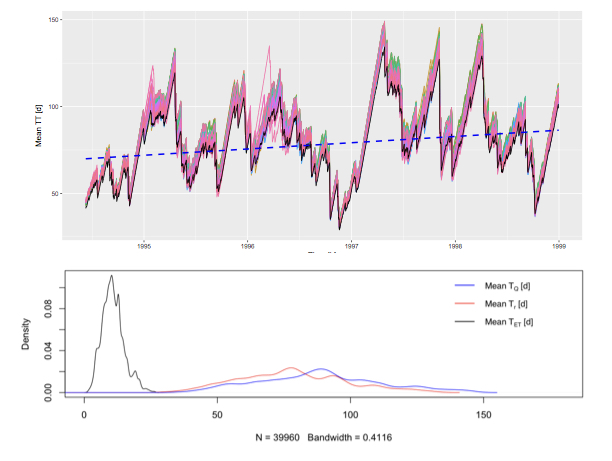Abstract
The increasing impacts of climate changes on water related sectors are leading the scientists' attentions to the development of comprehensive models, allowing better descriptions of the water and solute transport processes. "Getting the right answers for the right reasons", in terms of hydrological response, is one of the main goals of most of the recent literature. Semi-distributed hydrological models, based on the partition of basins in hydrological response units (HRUs) to be connected, eventually, to describe a whole catchment, proved to be robust in the reproduction of observed catchment dynamics. 'Embedded reservoirs' are often used for each HRU, to allow a consistent representation of the processes. In this work, a new semi-disitrbuted model for runoff and evapotranspiration is presented: five different reservoirs are inter-connected in order to capture the dynamics of snow, canopy, surface flow, root-zone and groundwater compartments.
The knowledge of the mass of water and solute stored and released through different outputs (e.g. discharge, evapotranspiration) allows the analysis of the hydrological travel times and solute transport in catchments. The latter have been studied extensively, with some recent benchmark contributions in the last decade. However, the literature remains obscured by different terminologies and notations, as well as model assumptions are not fully explained. The thesis presents a detailed description of a new theoretical approach that reworks the theory from the point of view of the hydrological storages and fluxes involved. Major aspects of the new theory are the 'age-ranked' definition of the hydrological variables, the explicit treatment of evaporative fluxes and of their influence on the transport, the analysis of the outflows partitioning coefficients and the explicit formulation of the 'age-ranked' equations for solutes. Moreover, the work presents concepts in a new systematic and clarified way, helping the application of the theory.
To give substance to the theory, a small catchment in the prealpine area was chosen as an example and the results illustrated.
The rainfall-runoff model and the travel time theory were implemented and integrated in the semi-distributed hydrological system JGrass-NewAge. Thanks to the environmental modelling framework OMS3, each part of the hydrological cycle is implemented as a component that can be selected, adopted, and connected at run-time to obtain a user-customized hydrological model. The system is flexible, expandable and applicable in a variety of modelling solutions.
In this work, the model code underwent to an extensive revision: new components were added (coupled storages water budget, travel times components); old components were enhanced (Kriging, shortwave, longwave, evapotranspiration, rain-snow separation, SWE and melting components); documentation was standardized and deployed.
Since the Thesis regards in wide sense the building of a collaborative system, a discussion of some general purpose tools that were implemented or improved for supporting the present research is also presented. They include the description and the verification of a software component dealing with the long-wave radiation budget and another component dealing with an implementation of some Kriging procedure.

Congratulations Marialaura! well done!!
ReplyDelete